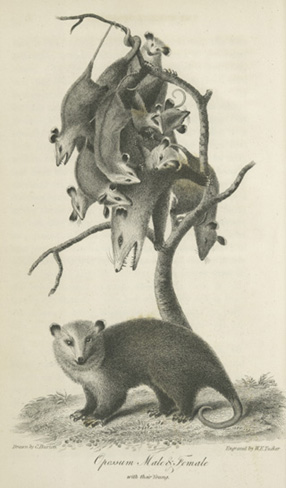

• Intro / Home
• Historical Neighbors
• Street and Backyard
Neighbors
• Park and Green Places
Neighbors
• Shore and Wetlands
Neighbors
• Salt and Freshwater
Neighbors
• Tiny Neighbors
• Unwelcome Neighbors
• Occasional and
Unexpected Neighbors
•
Wildlife Sighting Log
• Resources
• Hours and Tours
• Press Release
• NYPL HOME
| Park and Green Places Neighbors | |
Opossums, which are usually nocturnal, and thus rarely
seen, are the only representatives in North America of marsupials
(the predominant mammals of Australia), whose young are born in
an embryonic stage and complete their development attached to a
nipple in an external maternal pouch. Adult Opossums are about the
size of small dogs, and although they do use their prehensile tails
to hang from tree limbs, as shown in this early and somewhat inaccurate
illustration, they make their homes in hollow logs, rock piles,
crevices, and underground burrows, mostly in wooded areas. Opossums
feed on a wide variety of small animals including insects, birds,
reptiles, mammals, mollusks, and, in season, berries, fruits, and
vegetables. Despite its title, American Natural History,
which appeared in several editions, is exclusively about mammals. Check out the sighting log to record your interaction with some of the native New York City wildlife, such as the Opossum, featured in Urban Neighbors. You may also browse the sighting log by animal, borough, park or natural area, and/or habitat to view a sighting you have submitted or to read others’ observations. |
